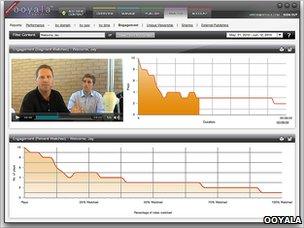Corporate video conquers the internet
- Published

Screenshot: More and more companies are using online video on their websites
"Only in Australia could we do those sorts of videos. Anywhere else it would be a bit, 'Oh, I don't know about that'."
Sean Ashby is the founder of Aussiebum, an Australia-based underwear manufacturer. Central to their e-commerce offering is video, and Mr Ashby credits it with helping pushing turnover up 40% from Au$16m to Au$23m during the global financial crisis, at a time when other retailers were suffering.

Brief encounter: Aussiebum uses video to promote its Wonderjock underwear
"When internet retail started they said that it would never overtake the experience of going into a store and shopping.
"I think the same could be said online about video. Nothing can replace the experience of video compared to just an image. Video is the biggest competitor to shopping in a store itself."
Their videos are a quirky take on popular Australian culture, external, and showcase the brand's products - including the Wonderjock, a brief that does for men what the Wonderbra does for the ladies.
"Back in the early days we recognised that content is king online, and while everyone was still on the image side we'd already transferred to video.
"What's funny is that we do it in a manner that is still fun. It's very Spinal Tap. And what's cool is that people buy into that fun."
Having hosted their video in-house initially, two years ago Aussiebum moved their video to online video platform (OVP) Brightcove.
"The challenge we had was the bit transfer rate, so someone in the UK or the US is able to watch the video without it clogging up or starting and stopping."
Video revolution
Quality video online used to be the preserve of media organisations, but technology research company Gartner says that take-up by non-media companies is expanding rapidly.
Gartner lists video as one of it's top ten strategic technologies for 2011, and is predicting that by 2013 video will be commonplace online, with 25% of content viewed on the web being pictures, video or audio.
As broadband and high-speed wi-fi becomes ubiquitous the ability of consumers to view video on their home connections and in offices has increased. The launch of video-sharing website YouTube in 2005 marked the beginning of video's move into the mainstream.
There's now a host of similar websites to choose from out there, including Vimeo, Dailymotion and Megaupload.
For businesses these sites have offered cost-effective means of having video embedded on their sites and distributing it to a wider audience.
Online video platform (OVP) companies have also proliferated, who will host your video with the option of customised players you can embed in your site, and give you in-depth analysis of customer behaviour. Some will also allow you to add advertising to your video and/or use a pay wall.
Two of the biggest players in the market are Brightcove and Ooyala
Brightcove chief executive Jeremy Allaire has already seen a shift in customer base and attitude. The company already has a number of high-profile media clients including the New York Times and the Discovery Channel.
"We more than doubled the number of our customers in the first half of 2010, and the lion's share came from non-media customers… starting about two years ago, very organically, we got companies, non-governmental organisations, they were all looking for a platform for their video."
The company operates on a monthly subscription basis, dependent on the number of videos you want to have online and the amount of times people view them, starting at $99 for 50 videos and 40gb of bandwidth. Brightcove has more than 1,500 customers in 45 countries.
Mr Allaire is clear on the benefits of video content for business.
"If your website has video, then it will rank higher in Google rankings, it gives a natural lift in SEO. Users that engage with video spend more time on your website, and more time spent equals higher engagement, whether you are Nike or an NGO.
"We have very clear data: Video drives higher sales, there is a conversion lift in the double digit percentages, and for some it translates into a 100% lift."
Offering a branded, embedded multiformat video experience is central to this, believes Mr Allaire.
"A video of a Thomas Pink shirt on YouTube doesn't do any good, but on their own website, as part of their brand experience, the brand context and the e-commerce experience - then it is very different."

Ooyala's Backlot platform allows detailed analysis of viewer behaviour
"We create a unified platform for customers, we sniff which browser is used, which operating system and deliver the video in a way that is preserving the brand experience - whether it is HTML 5, Flash, in an app, Java or anything else."
Ooyala is another giant in the OVP field. The California company delivers video to over 100 countries and numbers Red Bull and the Telegraph Group among their clients. Bismarck Lepe, one of Ooyala's founders and president of product strategy, says their company has also seen a shift.
"We originally started with the goal of primarily working with media companies. Today about 30-40% of our business actually comes from non-media companies using video."
Like Brightcove, Ooyala hosts video on a subscription basis, with their cheapest package starting at $500. Beyond hosting they see analytics and giving clients the ability to create revenue from, or monetise, their content with their Backlot platform as their big selling point.
"When we started the company the focus was around analytics and understanding consumer behaviour, and on that we actually built a very sophisticated and robust publishing platform."
Mr Lepe says publishing video will inevitably get easier.
"I think that building a business with online video in a more targeted fashion, it's going to become more difficult as audiences become more fragmented. And that's where we think we can add tremendous value."

23 Video creates branded videosites for their clients
Taking a different approach Danish company 23 has launched a video platform called 23 Video, focused on developing branded video sites that slot into existing web presences with a flat-rate monthly subscription. They already have corporate clients including Carlsberg and pharmaceutical company Novo.
Co-founder of 23 Thomas Madsen-Mygdal agrees that companies providing OVPs need to find added value.
"Video's becoming a normal part of the web, and the web is about sites, so what we're focused on is making it easy to build video-centric websites."
"The basic uploading of video, it being encoded, that's going to become part of all standard systems, it's all the other stuff, the tracking, analytics, user experience, that's behind the video site part."
Cutting your cloth
To SMEs the cost of using some of these services can seem prohibitive. Ooyala's Bismarck Lepe thinks that YouTube is a great way to get started.
"We think it is a tremendous tool, it's phenomenal, we actually syndicate out to both YouTube and Vimeo but we educate our publishers to make sure they understand it's not a walled garden experience. They can't control their overall brand experience."
Open source video platforms like Kaltura can provide cost-effective solutions. Beyond that, hosting your own video is also an option. Actress Flora Montgomery is the founder of Monumental Adventure, a travel website that features high-quality short films shot in locations across the world, which they host themselves.

OneLine Film's Flora Montgomery (right) thinks the market is ready for high-end online video
She says the market for video has revolved 180 degrees since she started the company three years ago
"At that time everyone on the net thought that it was about dogs on skateboards - no one was really prepared to invest in high-quality content online.
"It's almost the exact opposite online at the moment. Online is a more intelligent, more respected means to getting your message across and now we've got people who really want our content and want to buy it."
This has prompted Ms Montgomery to start a new company, OneLine Films, offering bespoke corporate video, which clients can host themselves with a custom-designed player.
"Now that people realise they can sell themselves online and that it's not dumbing down, it's actually a really intelligent way to get their business message online. The market's ready."
'Transformational moment'
Analyst Whit Andrews of Gartner has no doubt that the cost of online video is dropping as more providers enter the market and the technology becomes more accessible.
"If you look at the market for enterprise video today we've already seen the shift that is very common beginning to happen. You start with something that is expensive and difficult and rare and you move to something not rare many more appealing options"
Mr Andrews is also unequivocal that the growth of video online is going to continue.
"Surveys indicate that four out of five users watch video at least once a month. Increasingly I'm hearing stories about people who use publicly hosted videos to accomplish tasks that would previously have been done in text.
"If you think about the emotional impact [of video] and the elucidation of visual complexity - this is a genuinely transformational moment. YouTube will have as much impact as Google in how we think about information."